
Please welcome web mistress of The Emma Adaptations Pages, Graphic and Web Designer of Strangegirl Designs, and Regency fashion and style authority Kali Pappas today, as she chats about the “frivolus distinctions” of fashion in the two movie adaptations of Northanger Abbey. Enjoy!
“Dress is at all times a frivolous distinction, and excessive solicitude about it often destroys its own aim. Catherine knew all this very well; her great aunt had read her a lecture on the subject only the Christmas before; and yet she lay awake ten minutes on Wednesday night debating between her spotted and her tamboured muslin, and nothing but the shortness of the time prevented her buying a new one for the evening.” Chapter 10
***
Ever since “Her love of dirt gave way to an inclination for finery,” Catherine Morland has yearned to experience society – balls, gowns, boys, and all the excitement and adventure that every naive young woman on the cusp of adulthood eagerly anticipates. Since Miss Morland’s first grand, grown-up adventure takes place in Bath – the famous health spa and mythic center of Georgian society and fashion – it’s only natural that dress, as frivolous a distinction as it may be, should play a distinguished part in the drama that unfolds before our heroine.
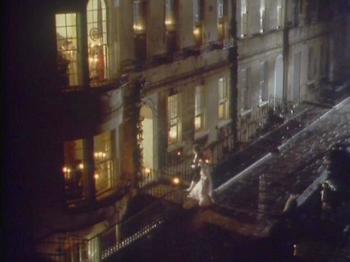
NA 1986: Parties galore are evident upon arrival in Bath!
With clotheshorse Mrs. Allen as her chaperone and first advisor on things sartorial, Catherine costumes herself for a dual role – that of a garden-variety romantic heroine on the loose in a fancy town, in addition to that of a wannabe gothic heroine whose imagination tends toward the horrid. Both the 1986 and 2007 adaptations of Jane Austen’s Northanger Abbey use fashion to play up the romance and hyperbole presented in this gothic parody, though sometimes in starkly different ways. While the 2007 adaptation is relatively subtle in its costuming, the 1986 adaptation veers a bit more toward the cartoonish at times.
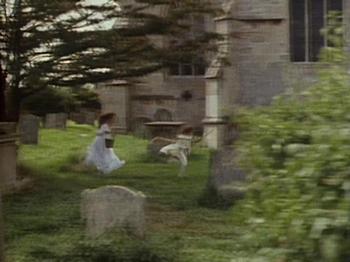
NA 1986: Catherine and her brother dash through a rather gothic-appropriate graveyard.
In the novel, clothing and one’s relationship with it function as more than mere “frivolous distinctions,” despite the authoress’ narrations to the contrary. It is, after all, it’s Henry Tilney’s knowledge of muslin which proves his “genius” to Mrs. Allen. “Men commonly take so little notice of those things,” she tells him. “I can never get Mr. Allen to know one of my gowns from another.” While Mrs. Allen’s comfort in Henry’s knowledge is superficial, his interest in matters of feminine importance shows us as readers that he’s a sensitive guy who makes an honest effort to understand and appreciate girls.
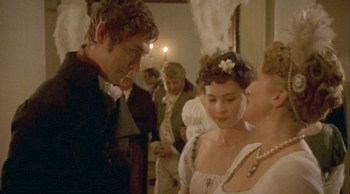
NA 2007: “I gave but five shillings a yard for it, and a true Indian muslin!”
In the television adaptations of the story, one could argue that fashion is an even more important distinction, given the visual dimension of the medium. Aside from the usual quick inferences it allows a viewer to make – regarding class and age, for example – it also subtly informs us as to the personality and even the motives of the wearer.
In both adaptations, Catherine first appears as a clean, blank, and thoroughly transparent being. She is the antithesis of artifice, wearing sheer, simple muslin gowns in virginal white. Her hair is uncomplicated, even a bit unkempt. In the 1986 adaptation, we find her reading in a tree; in dirty stocking feet, no less, which indicates that while her “inclination for finery” may be considerable, her tolerance of dirt has not yet subsided. She is not yet a fully-civilized “adult.’

NA 1986: Early Catherine reading in a tree
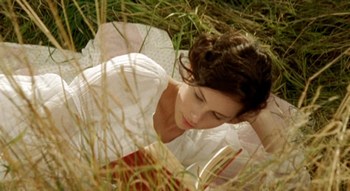
NA 2007: Catherine reading novels
In the 1986 adaptation, Catherine begins her transformation upon embarkation for Bath, suited up in simple yet elegant new travelling togs which appear to consist of a smart new bonnet, a new gown, and a satiny-blue pelisse over it.
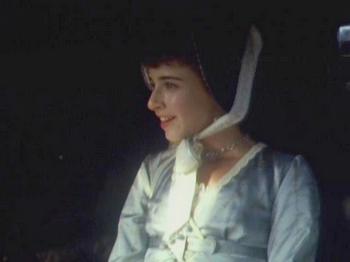
NA 1986: Catherine embarks for Bath

NA 1986: Catherine’s elegant traveling togs
2007 Catherine appears on the scene in Bath in similar fashion, shopping in what appears to be an attractive, moderately high-crowned hat of brown straw worn bonnet-style with a blue ribbon tie. Her textured spencer jacket and patterned muslin gown are uncomplicated, yet very elegant:

NA 2007: Catherine arrives in Bath
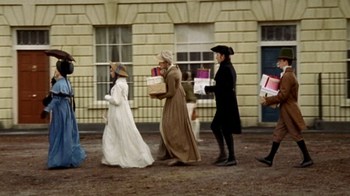
As Mr. Allen proclaims in this latter adaptation, “Money must be spent.” Mrs. Allen makes certain that she and Catherine take this maxim to heart, with Catherine in a long, white pelisse
Soon after, Both 1986 Catherine and 2007 Catherine make their ball debut in sprigged muslin gowns. 1986 Catherine’s version is a bit fussier, more feminine, and more in line with the mid-to-late 1810s penchant for trimmings than her later counterpart’s, but both heroines represent themselves well.
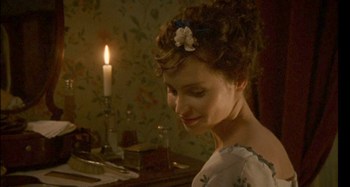
NA 2007: Spriggled muslin ballgown
“Her hair was cut and dressed by the best hand, her clothes put on with care, and both Mrs. Allen and her maid declared she looked quite as she should do. With such encouragement, Catherine hoped at least to pass uncensured through the crowd. As for admiration, it was always very welcome when it came, but she did not depend on it.”

NA 1986 sprigged muslin ballgown, with the bonus of Mrs. Allen’s hyperbolic mid-late 1810s tabbed-and-slashed sleeves and huge “poke” bonnet (poke bonnets are a later style, but this brim is so massive it looks close)
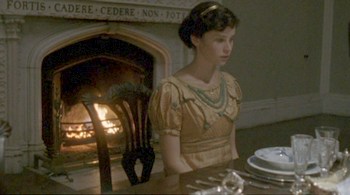
2007: Catherine’s new dinner gown, worn at Northanger Abbey. In late 1810s style, it features a vandyked bodice and puffed, tabbed sleeves.

NA 1986: Northanger Abbey party: Catherine wears a gown with a vandyked bodice and interesting straight, “laced” sleeves.

NA 2007: Both the 1986 and 2007 Catherines wear prominently-featured cross pendants.
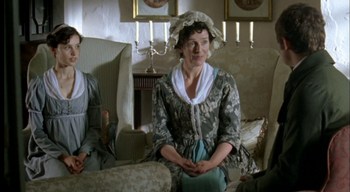
NA 2007: Mother and daughter dressed alike
In the 2007 NA Catherine appears at the end of the program looking very much like a “mini” version of her mother, the solid, hard-working clergyman’s wife. “Her mother was a woman of useful plain sense, with a good temper, and, what is more remarkable, with a good constitution.” In marrying Henry, we presume that Catherine herself will become the very same sort of parson’s wife. Catherine’s mother appears to be wearing a rather old-fashioned kind of dress here; a straight-sleeved, flat-bodiced 18th century robe a l’anglaise with a petticoat showing through the front split of the skirt.
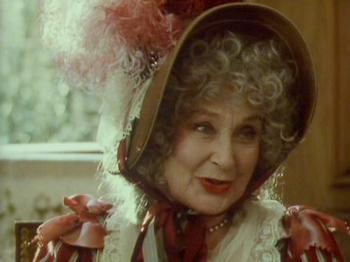
NA 1986: Mrs. A in a fussy, beribboned visiting gown and colorful feathered hat worn bonnet-style.
Mrs. Allen, too, is “coded” by her clothing. She has a passion for fashion which is evident in both adaptations, though it is manifested differently in each. In the 2007 adaptation, her ensembles are only moderately ostentatious, if they are ostentatious at all. In the 1986 version, however, her wardrobe is frequently outlandish, featuring bright colors, profuse trimming, huge hats, and lots of tall feathers. This love of ribbon trims, puffed sleeves with tabwork and vandyking, and other decorations puts 1986 Mrs. Allen very squarely in the mid-late 1810s (which makes sense, given that the novel was published in 1817).
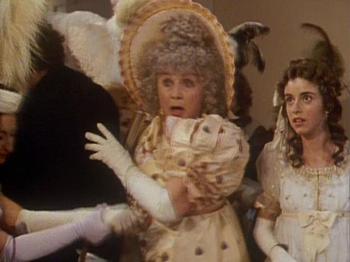
NA 1986: Mrs. A’s “muslin” ballgown is actually a smooth-weave silk, it looks like.
NA 2007: Mrs. A’s Bath walking ensemble is a plumed, 1817ish hat worn bonnet-style, moss-green pelisse with rushed upper sleeves, an Emerald green silk gown and a reticule.

NA 2007: Mrs. Allen and Catherine at the Opera
2007: Mrs A’s opera gown, trimmed with a Greek key design. Georgian Britain loved Hellenic and Hellenistic art, which is evident in the Grecian hairstyles and high-waisted, chitonesque gown styles of the first decade and a half of the 19th century. The classical craze was fueled in part by Lord Elgin’s removal of sculpture from the Parthenon (and several other structures on the Athenian acropolis) to England in the early 19th century.

2007: Mrs. A calls on the Morlands wearing a large, frothy bonnet and a gown with an oddly-vandyked yet fittingly mid-late 1810s bodice.
The Thorpes mark the biggest costuming difference between the adaptations, I believe. The 2007 Thorpes are smarmy, but not so alarmingly so that one would expect Catherine to immediately question their sincerity. The 1986 Thorpes, on the other hand, are over the top in dress as well as personality. Isabella’s cloying, candy-colored wardrobe and saccharine manner make it obvious she isn’t for real, while John’s outright brutish manners and utter tastelessness turn the stomach.

NA 1986 Thorpes: Mother-daughter plumage!
Isabella’s red hat and pelisse serve as a warning; scarlet woman! Stop where you are! Meanwhile, John Thorpe insults his mother: “Where did you get that quiz of a hat? It makes you look like an old witch.”

NA 1986: Isabella in what appears to be a crazy turban and a striped pelisse vs. Catherine in flat-crowned hat worn bonnet-style and a white muslin gown under a blue and white pelisse.

NA 1986: Isabella wears a toothache-inducing purple pelisse ensemble with a plumed bandeau on her head. This was the ball scene where she ends up dancing with Captain Tilney, yet I can’t help but think how unballgownlike this outfit really is.
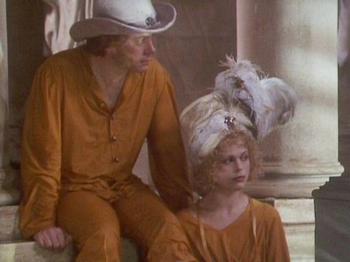
NA 1986: Isabella and John at the baths, seething as Catherine socializes with Eleanor Tilney. The effect of their bathing clothes plus street headwear is amusing.
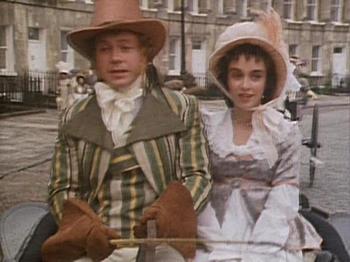
NA 1986 John Thorpe: His dandyish green-striped coat and waistcoat look ridiculous – and check out the matching rust-colored gauntlets and hat! “Such a rattle,” indeed!

2007 Thorpes: Smarmy, but not quite as Smarmy as the 86ers. Isabella sports a tall, mid-to-late 1810s hat.
While it’s not immediately apparent that 2007 Isabella is a passive-aggressive golddigger, she’s pretty free with the cleavage right off the bat (Regency cleavage was kind of the norm, but when juxtaposed with Catherine’s modesty, it’s a little startling). That in itself is a warning of sorts, I suppose. As the 2007 adaptation wears on, the personality differences between Catherine and Isabella become more apparent in their behavior and in their dress. While Isabella continues to play up her cleavage, Catherine continues to wear modest gowns in demure colors.
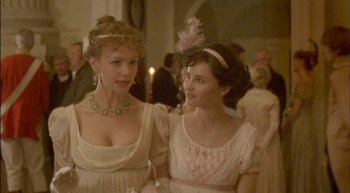
NA 2007: Ballgown juxtaposition.
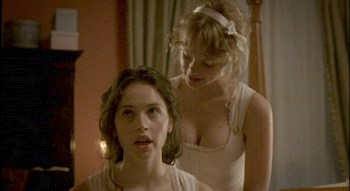
NA 2007: Catherine and Isabella dressing for a dance.
2007: Speaking of cleavage, Isabella is shown here wearing a corset that seems to straddle the line between fully-boned, gussetless, and conically-shaped 18th century styles and the more natural lines of the classic, gusseted, long Regency corset.
While Isabella vainly solicits and encourages male attention in the 2007 adaptation, Catherine sometimes appears blissfully unaware of her appearance.

NA 2007: Isabella wears a fashionable Lunardi-style hat with an embroidered crown, Catherine continues to wear a somewhat ratty, barely-blocked bonnet.
2007 John is not quite so dandified as 1986 John; his clothing is more understated, though his manner is almost as “rattlish.”

NA 2007: James Morland and John Thorpe
Henry and Eleanor Tilney, on the other hand, epitomize elegance and goodness in both adaptations. In the novel, Mrs. Allen tells Catherine, “Go, by all means, my dear; only put on a white gown; Miss Tilney always wears white.” While 2007 Eleanor wears some white, 1986 Eleanor very nearly always wears white, or some other light color.

NA 2007: Eleanor Tilney in white, meets Miss Morland

2007 Tilneys: Simple yet elegant young people. Eleanor’s lowish waistline and ballgown belt and buckle seem to foreshadow the styles of the 1820s and beyond.

NA 1986 Tilneys: Unaffected and transparent, yet elegant. Eleanor wears white, just as Mrs. Allen alludes in the novel.
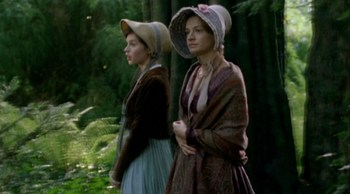
NA 2007: Eleanor Tilney in an elegant shawl walks with Catherine
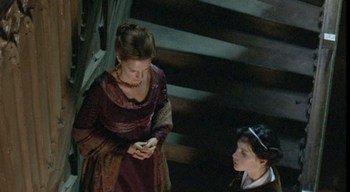
2007 Tilneys: Eleanor wears rich, somber colors, including a gorgeous patterned cashmere shawl. Similar shawls were in vogue from the late 18th century through the 1860s.
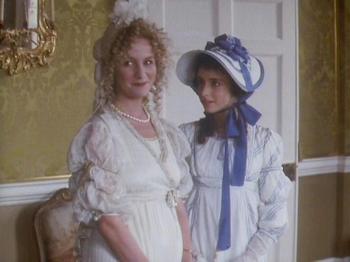
NA 1986 Tilneys: Eleanor is pure and elegant in her white-stripe ensemble, complete with gathered (perhaps ruched) sleeves and a simple string of pearls.
But while the two younger Tilneys are all that is pure and good, their father – in both adaptations – is a rather stern, dark sort of character. When not in uniform, 1986’s General Tilney often wears a smart red wool coat that echoes and reinforces his commanding “military presence.” He also wears his hair in an older, 18th century style, as would fit his personality and his generation, I suppose. He is pictured here with his friend Madame du Thierry, who is one frightening creature. Face laden with white powder and 18th century style novelty-shaped beauty marks, she dresses in spectacular, bespangled mourning black for her guillotined husband.
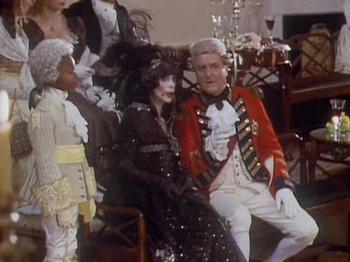
NA 1986: Madame de Thierry and General Tilney represent an older generation in dress.

NA 1986: General Tilney in a smart red coat, echoing his commanding “military prescence”.
Beyond the “normal” portrayals of life at Fullerton, Bath, and Northanger Abbey itself, both adaptations make use of daydream sequences in which Catherine imagines herself the heroine of a gothic romance. She often visualizes herself draped in magnificent, shroudlike gowns while trapped in some sort of horrid situation straight out of a Radcliffe novel. The 1986 dream sequences are more bizarre and involved than the 2007 sequences, which means a bit more diversity in costuming.

NA 2007: Gothic fantasy time for Catherine

NA 2007: Catherine’s flowy white “dream sequence” gown.

NA 1986 – Virgin sacrifice? You bet! Catherine, wrapped in something gauzy and white that barely qualifies as a gown…

NA 1986: Catherine looks rather like the heroine pictured in her copy of Udolpho!

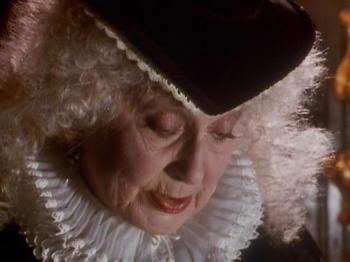
NA 1986: Catherine and Mrs. Allen dressed in 16th century garb, as characters in a gothic dream sequence inspired by The Mysteries of Udolpho.
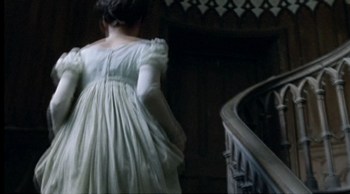
NA 2007: Not a dream sequence, but Catherine – in search of adventure – looks like a ghost floating up this gothic staircase in her light gown.
In all, both adaptations offer interesting “alternative” views of the story and its characters through clever costume choices. Dress is at *no* times a frivolous distinction in these two excellent adaptations.
Kali
-
Visit Kali’s web headquarters at strangegirl.com
-
Visit Kali Pappas’ web site The Emma Adaptations Pages
-
Visit Kali Pappas’ Strangegirl Designs (who designed our beautiful Go Gothic artwork)
-
Learn more about Regency fashion at Jane Austen’s World
Upcoming event posts
Day 10 – Oct 16 Group Read NA Chapters 15-17
Day 11 – Oct 19 Book Review – NA Naxos Audio
Day 12 – Oct 20 Guest Blog – Valancourt Books
Day 13 – Oct 21 Group Read NA Chapters 18-21
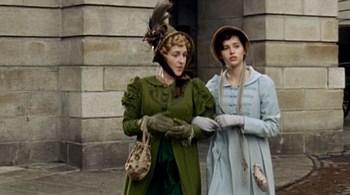
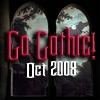
I this was wonderful! I really enjoyed looking at all the costumes and such!
LikeLike
very nicely done. i think that it’s always so interesting to see how current fashion influences the choices in costuming a period film. no matter how accurate the costuming is for the time, i think the 86 version certainly reflect the over the top fashion of the 80’s as well.
LikeLike
Both of these movie costumes are not quite satisfying to me. The 1986 is closer to my vision since the designer exaggerated the styles and colors to make it campish. I like that aspect since Northanger Abbey is a parody — and they tried to make the costumes a parody of the times as well. The outrageous bonnets with feathers and the garish colors all distract too much from the story though. Each new scene brought another outrageous costume to take away from the actors or plot. On the other hand the 2007 movie is too staid and normal. The clothes are beautiful, but too real. If I could, I would meld the two designers styles and it might be just right. ;)
A big thank you to Kali, who really did her research, to our better enjoyment.
Cheers, Laurel Ann
LikeLike
Love the distinctions in time period to show people as fashion forward or backward. To me, that is one of the smartest things a designer can do, because it feels much more real than having everyone always at the height of period fashion trends.
LikeLike
Hi guys! Glad you enjoyed the post. Big thanks to LA for including me in this awesome event!
I love that mother/daughter screencap more and more every time I see it. C and Mrs. M look so alike and yet so very different; Mom with her Anglaise-ish, low-waisted dress and Catherine in mid-decade poofy sleeves and wacky-high waist.
LikeLike
* make that “in mid-decade, long, poofy-capped sleeves”
Forgot to edit before I pressed “submit.” xD
PS – I was talking with somebody about 86 Isabella’s purple “open pelisse” ensemble, and learned that according to _Patterns of Fashion_ and Jessamyn at Regency Costume Companion, this style is probably more properly categorized as an early-19th century robe than a pelisse. The open front is definitely anachronistic for the mid-late 1810s, and very likely would have been a general “evening” look rather than a ball style.
Here’s a page from Cathy Decker’s Regency Fashion site featuring an open-robe style ensemble ca. 1802, from a German publication: http://hal.ucr.edu/~cathy/year/1802.html
LikeLike
I LOVE the costumes on the (newer) film versions of JA’s books! They truly reflect character, personality, etc. They are BEAUTIFUL, too, even the simple stuff.
LikeLike
Loved all the comparison photographs! Thank you so much for the labor of work it takes to post for our pleasure! Have a great day!
LikeLike
Those costumes are gorgeous.
LikeLike
Brilliant post! I especially liked the note about Catherine being a mini-Mrs. Morland.
One thing I wondered – is it possible that the 1986 version played to 1980s fashion taste, perhaps in hairstyles? The very high, curly hair in the adaptation combined with the synthesized and electronic guitar soundtrack really screamed “80s movie” to me.
LikeLike
I love learning more about the costumes in movies. Thanks!
LikeLike
Definitely! :D
I don’t know who originally came up with this rule of thumb, but it is often paraphrased:
“When it comes to the movies, sets and furnishings are often, if not usually, period-correct. Costumes are *sometimes* period-correct. Hairstyles are occasionally period-correct. Makeup is almost NEVER period-correct.”
LikeLike
Wonderful photo essay! My gaze at the costumes in the new NA will be much sharper for having read this. The 1986 version is one of my all-time favorites: Catherine Morland’s simple gauzy gowns seemed to highlight her youth and naivete, even among the very young Austen heroines. And her Udolpho sequences respect the popularity of Ann Radcliffe, stopping just shy of parody. Isabella Thorpe is unforgettably smarmy and fetching at the same time in her ridiculous turbans, headbands, and feathers–her brother I’d rather forget, both the clothes and the man! The new Tilney will have to go a long way to beat the dapper and ever-bemused Peter Firth.
Thanks Kali and Austenprose for this great article!
LikeLike
I really enjoyed the comparison of costumes. Thank you.
LikeLike